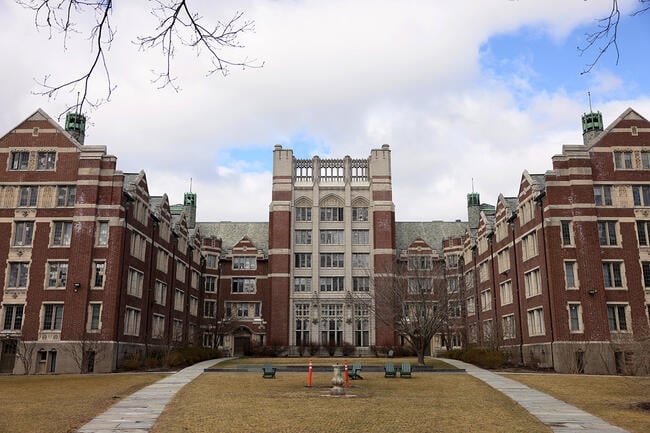You have /5 articles left.
Sign up for a free account or log in.

Wellesley College in Massachusetts has become the first U.S. institution to top $100,000 per year.
Jessica Rinaldi/The Boston Globe/Getty Images
Wellesley College appears to be the first higher ed institution in the nation to hit the $100,000 annual sticker price.
The cost to attend the all-women’s college this coming fall will be $100,541, as Boston Business Journal first reported. That includes direct costs of $92,440—which covers undergraduate tuition, housing, fees and meals—plus indirect costs, such as books, personal expenses, travel, transportation, and optional health insurance. Wellesley now appears to be the most expensive college in the country.
Various other universities have approached the six-figure mark for undergraduate tuition and indirect costs in recent years but managed to remain below it. When Course Strat explored this issue last year, it appeared that Vanderbilt University might be the first to cross the threshold, with estimated costs for undergraduate students in certain programs, such as engineering, hitting almost $98,000. Others at or over the $90,000 line include the University of Chicago, the University of Southern California, Washington University in St. Louis and Tufts University, and a handful of other highly selective, private institutions.
Wellesley spokesperson Stacey Schmeidel wrote in an email to Course Strat Tuesday that the college “meets 100% of the calculated need for all students” and is “committed to making a Wellesley education accessible to all.” Additionally, she noted that “loans are eliminated for students with total parent income less than $100,000 and calculated family contribution of less than $28,000. The average indebtedness of our 2023 graduates is $18,500, well below the national average.”
She added that indirect costs vary by student and “the majority” do not pay sticker price.
Schmeidel also wrote that more than 50 percent of students decline the optional health insurance, which, at $4,051, is the most expensive item on the list of indirect costs. Of those who do opt in, nearly half receive institutional grants to cover the entire cost, she noted.
Despite the potential sticker shock, Wellesley’s website plugs an education that is “more affordable than you think.” Wellesley has a financial aid budget of more than $84 million, according to its website.
That is also the case at many other well-endowed colleges where, regardless of the listed price, most students don’t pay the full amount. Tuition discounting has soared in recent years and remains well over 50 percent across the U.S. A recent study of 325 private nonprofit colleges conducted by the National Association of College and University Business Officers pegged the average tuition discount rate for first-time, full-time students at 56 percent, and 52 percent for all undergraduate students. Both numbers are all-time highs.
While public concerns about higher education have often focused on college costs, debt and the return on investment, Wellesley and its high-priced peers are outliers in terms of cost. A recent College Board analysis found that in the 2024–25 academic year, the average sticker price was $43,350 for private nonprofit four-year institutions, $30,780 for out-of-state students attending public universities, and $11,610 for in-state students at public universities.
Bryan Alexander, a senior scholar at Georgetown University who has been writing about college costs nearing the $100,000 mark since 2018, correctly predicted in 2023 that Wellesley would be one of the first institutions to reach six figures by the 2026–27 academic year.
Asked what he thought about his prediction coming to pass, Alexander responded with multiple questions.
“Will this pricing make the college more desirable, as a luxury good? Or will it drive away would-be students from sticker shock?” he wrote by email. “How many universities, scared of [the Trump administration], will make such a price hike to raise funds when grants are cut?”
He also pondered what it might mean for public perception, writing, “Wellesley is a small liberal arts college, but some universities are also playing this pricing game. Will [small liberal arts colleges] become seen as too pricey, or will all of higher ed get tarred with this brush?”








